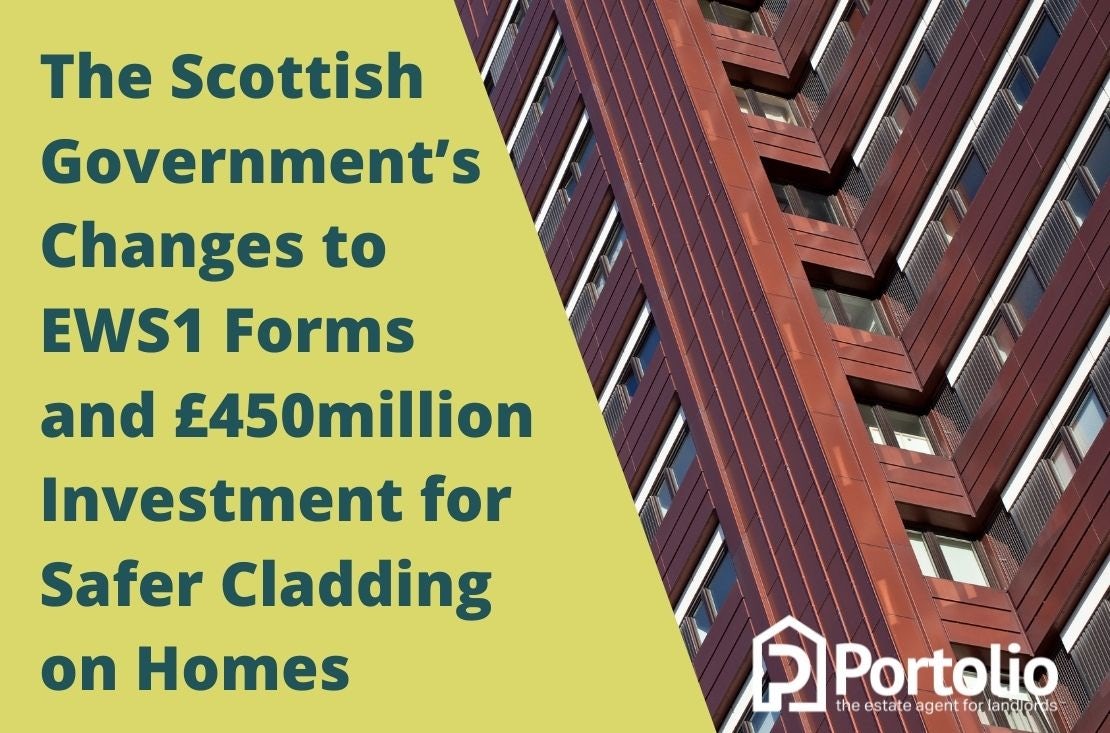Everyone has a right to feel safe in their home – and as a landlord, you want to be able to sleep at night knowing your tenants are safe, too.
If you have a new build or modern buy-to-let property, you may already have heard there’s been some changes to EWS1 forms and process, following the Scottish Government’s £450million pledge towards making homes safer.
This is such a welcome move for landlords who want to ensure their tenants are safe from the risks of dangerous cladding, sadly brought to light by the tragedy of Grenfell back in 2017.
According to the Scottish Government, a minimum of 85 high-rise blocks and over 130 buildings (mostly schools) contain high-pressure laminate (HPL) panels. Furthermore, 23 of Scotland’s 774 high-rise buildings are reported to contain combustible polyethylene-type ACM panels.
Also mentioned in the above link was the fact that automatic fire suppression equipment was only reported to be present in 39% of high-rise buildings.
With all this in mind, it seems clear that changes are necessary – so, what are they exactly, and what will they involve?
Here, I’m going to go into a little more detail about the changes to EWS1 forms – soon to be Single Building Assessments – and what they’ll mean for you (if you’re affected) as a landlord.
But first…
EWS1 forms: a bit of background
The EWS1 (External Wall System) process was first introduced in December 2019 so that lenders could have reassurance on the safety of external walls and the cladding being used.
Once this was introduced, lenders soon began requesting an EWS1 form – involving an assessment carried out by a qualified professional – when owners were looking to sell or remortgage properties.

Despite the EWS1 form not being a statutory requirement, the information was used for valuation purposes, leading to a value of £0 being put on properties that had potentially dangerous cladding. I’m sure I don’t have to tell you that no value means no lending.
Lenders may also refuse a mortgage application when an EWS1 is not produced, and would cost owners around £700 – £800 to have carried out on their single property – usually a flat in a much larger block.
Due to insurance issues, all EWS1 forms would have to be carried out separately for each property, rather than applied to a whole building, potentially leading to a lot of unnecessary expense for anyone else in the block looking to sell.
What are the changes to EWS1, and how are you affected?
Now, (and dependent on the outcome of the Scottish elections) common sense has prevailed, with ministers pledging to spend around £450m to help resolve issues with cladded properties in Scotland.
It’s a very positive step towards tackling the cladding crisis, especially for those stuck in the situation where they can’t remortgage or sell without an EWS1.
The commitment from the Scottish Government means all homeowners and residents of flats with external cladding will be offered free safety assessments – known as Single Building Assessments – and the main change is, the assessment will be carried out on the entire building, rather than single properties.
The move makes a lot of sense, and should perhaps have been in place several years ago, but if you’re a landlord or homeowner who has a property with cladding, this progress is good news and a positive step forward in 2021.
The decision – which was unanimously agreed by representatives of homeowners, surveyors, property managers, lenders and developers – will allow the free safety assessments to begin taking place in June, with remediation funding coming as soon as early August.

Here’s what Housing Minister Kevin Stewart had to say:
“This is an important milestone for people who are living in buildings with cladding. I have heard personally from homeowners who have had to change their life plans or are living with real concern about safety – no one wants that uncertainty and anxiety to continue.”
He continued: “By funding the Single Building Assessments we will have a clear picture of the scale of the issue. This will enable us to provide support for the remediation work required – I do not want people left facing unfair remediation costs. This approach will also save homeowners hundreds of pounds that they may otherwise have faced through paying for an EWS1.”
Advice from the property pros
I’d say that for a lot of buildings out there with cladding, there won’t be any issues at all; you’ll get the necessary assessment out of the way, and all will be well, with confirmation your building is safe to use.
However, there will be some cases where external work is required to the buildings. If it’s found this is the case for you, especially in the case of urgent repairs or replacement of cladding, it will be important to liaise with everyone in the building to ensure full cooperation for funded remedial work to be carried out.
Paul Nelis, Director of Fire Risk Assessment (Scotland) Ltd, told us:
“The EWS1 form and process was really developed with the English Housing Tenure in mind where blocks of flats are normally owned by one person or company, and the flats are leased out. In England the building owner would normally commission a single building survey for EWS1 purposes, and a share of the costs would be passed to each leaseholder.
“The process has caused problems in Scotland because each flat owner in Scotland actually owns their own property, and there are no legislative requirements for factors to get involved with the EWS1 process on behalf of the collective owners.
“At Fire Risk Assessment (Scotland) Ltd, we support the Scottish Governments new common-sense approach and changes to EWS1 processes.
“The new ‘single building survey’ process in Scotland will hopefully simplify the EWS1 process, and make it easier for homeowners in Scotland to sell their properties and/or apply for fixed rate mortgage deals and other home secured finance products.”
In summary…
The latest cladding safety changes to EWS1 forms and £450million funding have been widely regarded as a welcome move from the Scottish Government.
Hopefully now we can all work even more positively towards making Scotland’s homes safer.
If you’ve had an experience with external cladding/EWS1 forms, leave us a comment below – we’d love to hear about it.

Written by Chris Wood, MD & Founder of Portolio
Get in touch on 07812 164 842 or email [email protected]


we viewed a flat, in glasgow, recently which mentioned EWS1 form in the home report but it also stated that surveyor wasnt allowed to comment on it and we were point blank refused any right to read it before bidding.
The surveyor who conducted the Home Report is unlikely to be the same person who conducted the EWS1. We wouldn't recommend offering on a property without reviewing the ESW1. Your mortgage company would also request to review the EWS1 before they approved your mortgage application. If you need any further assistance please do not hesitate to get in touch with us. Chris & Ross.
Hi, We are selling our flat in East Kilbride and the estate agent has intimated that we will need an ESW1 form at a cost of £1000. I know of 3 owners who have an ESW1 report, on the building, which they paid for individually. They requested the report as they were buyers(required by lenders).
Do I need to pay for the report as a seller?
Thanks.
Hi William, the short answer is yes. The person buying your property will need an ESW1 that relates to your property. This is necessary as their lending will not provide them lending without one. So, you will need to pay for it, unfortunately. Single EWS1 (1 for the whole development) are currently not in use although the Scottish Government is looking to bring them in full use from 2023. I hope this helps. Ross
I'm trying to remortgage my flat in a 4 storey block. All the external cladding was removed and upgraded a couple of years ago. I have all sorts of evidence in the form of the contractor and council if what the cladding is made up of (all safe and non combustible) but my lender still won't accept with no EWS1. Do you think this is reasonable?
Hi Pauline, thanks for getting in touch. Unfortunately, your lender is likely to still require an EWS1 confirming the current cladding is non-combustible. It's a bit of a box-ticking exercise for them despite you having documentation demonstrating the cladding is suitable. The quicker the Government can move towards a 1 EWS1 per development the better. Ross
Good article.
We are looking at a penthouse flat with external wall cladding. Is it likely that these materials will also be underfloor or in the roof space or are we only likely to have issues with the walls? I assume a EWS1 will confirm the extent to which the problematic materials have been installed?
Thanks for posting a comment and for your positive feedback on our article. The companies carrying out the EWS1 certificates are very specialist, so they should be able to identify all areas of concern. The main area of concern is the external wall, hence why it's called an External Wall System certificate. If there is any doubt then the EWS1 will not be issued and therefore lending will not be approved. From our experience, they take a very cautious approach to avoid any future recourse action. If the building is less than 10 years old then the other parts of the building will be covered by 10 year NHBC warranty. I hope this helps. However, please do not hesitate to contact me if you have any further queries. Thanks, Ross.
I am in the process of selling my 3rd floor flat and have accepted and offer. I am now being told an EWS1 is required. Has the Scottish government made any moves to change to single building surveys yet? I know of 2 flats in my block of 8 that have sold within the last 2 years so there will be valid surveys carried out. Will this potentially hold up the sale of my flat?
Hi Kris, unfortunately the single EWS1 form isn't yet in operation. So, you would need to provide the buyer's lender with the EWS1 so they are satisfied the cladding isn't combustible and therefore lending will be approved. If other properties in the block have sold then I wouldn't expect a satisfactory EWS1 to be an issue. Best to find out who conducted these EWS1 and ask them to attend for you. Thanks, Ross.
hi i am selling my flat my wife and i are disabled i have copd and bladder cancer so i cant work any more i do not have £ 800 for a EWS1 how do i get 1 thanks
Hi Brian, thanks for your comment. You should get in touch with this company: https://www.fireriskassessmentservices.com/. I'm sure they will be able to assist you. Ross.
Hi I am selling a property in Edinburgh, I have had the ESW1 certificate completed. The buyers lender is now saying it needs all postcodes of the development on the certificate in order for them to lend. The company that produced it says that this isn’t legal in Scotland and the certificate only covers the property surveyed. Can you advise please. Thanks in advance.
Hi Carrie, thanks for your question. From our experience the lender should accept the EWS1 in the name of the seller with the address of the property when the property is located in Scotland. I'm aware the situation is slightly different in England where there is a single building owner and the people who own the flats are leaseholders. In Scotland each flat owner actually owns their property and the collective owners are the co-owners of all common parts of the building. So, perhaps the lender needs to review your case again as we've never been asked to make sure all postcodes are listed on a EWS1. The Scottish Government has been discussing a single EWS1 for each development, however this hasn't yet been implemented. Ross.